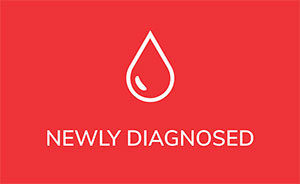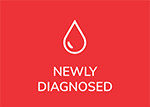Those with chronic lymphocytic leukemia or small lymphocytic lymphoma (CLL / SLL) have many healthcare considerations when it comes to managing their disease over time. For example, it is important to stay up-to-date on all recommended vaccinations (especially before treatment is required), keep an eye on how lab values are trending over time, recognize when any new B-symptoms occur that could signal the disease is progressing, and take additional infection control precautions due to being immunocompromised. But in addition to all of the above, since those with CLL / SLL are at higher risk for developing secondary cancers they must also understand what regular cancer screenings needed to occur and recognize the symptoms to report to their healthcare provider.
Let’s first discuss why those with CLL / SLL are at high risk for developing secondary cancers. When the immune system is functioning properly, certain cells that are part of the immune system recognize when cancerous cells develop, identify them as being abnormal, and then are continually working to kill them. Since CLL / SLL is a cancer of the immune system and causes varying degrees of immune system dysfunction, not only is there known difficulty in fighting off infection but the body can also have difficulty killing new types of cancer cells that develop. When a new, unrelated cancer diagnosis occurs in someone who has already been diagnosed with CLL / SLL, this is called a secondary cancer.
To be clear, any secondary cancer can occur. But those with CLL / SLL are known to be at high risk of developing the following types of secondary cancers:
-
- Skin cancer or melanoma of the skin
-
- Colon cancer
-
- Lung cancer
-
- Kaposi sarcoma
-
- Soft tissue sarcoma
-
- Prostate cancer (men)
-
- Breast cancer (women)
-
- Bladder cancer
Never put off or delay in letting your healthcare provider know about any new symptoms or problems that develop. In addition to having an expert CLL / SLL provider on your healthcare team, it is important to also build a team of specialists that you see for regular secondary cancer screenings (i.e., dermatologist, gynecologist, urologist, etc.,). And don’t forget to continue your annual wellness check-up with your primary care provider.
Below, we will briefly review some of the secondary cancer screenings CLL / SLL patients should consider in further detail. However, this list is not all-inclusive. So, it is important to ask your healthcare provider what exact cancer screenings you should be having on a regular basis and clarify how often you should have them. Their recommendations might be slightly different based on your personal medical history, genetic test results, family history, and other unique circumstances.
Skin Cancer
Skin cancers are particularly common in CLL / SLL. Skin cancer screening should be done at least annually, and more frequently if you have a family history of skin cancer or a suspicious area that needs closer monitoring. It is important to note that while these annual screenings can be done by your primary care provider, you might consider adding a dermatologist to your healthcare team. Dermatologists typically have more advanced equipment available and are extremely skilled in detecting suspicious spots and lesions on the skin that can be difficult to see with the naked eye. A general dermatologist should do a great job of performing skin exams annually to make sure no skin cancers are developing. When choosing a dermatologist (or any other specialist for that matter), it is a good idea to ask if your dermatologist is familiar with CLL / SLL and the associated increased risks of secondary skin cancers. There is also a subspecialist of dermatology called Oncodermatology. This is a dermatologist that has a special interest in caring for patients who have different types of cancer. For more information, including what you can do to prevent skin cancer, please read, “Understanding the Importance of Screening for Skin Cancer While Living with CLL / SLL.”
Colon Cancer
Not including skin cancer, colon cancer is the third most common cancer in the US. The most common symptoms of colon cancer include:
- Diarrhea or constipation that does not go away
- Discomfort or urge to have a bowel movement when there is no need
- Cramping pain in your lower stomach that persists
- A constant feeling of being bloated or feeling full
- Change in appetite that persists
- Blood in the stool or bleeding from the rectum
- Weight loss without dieting
Regular screening for colon cancer, beginning at age 45, is the key to preventing this cancer and finding it as early as possible. The U.S. Preventive Services Task Force recommends that all adults aged 45 to 75 be regularly screened for colon cancer. Those adults aged 76 to 85 should talk to their doctor about whether to continue regular screenings. There are many types of tests now that can screen for colon cancer, including simple stool sample tests. However, a colonoscopy is often preferred over stool tests to screen for this type of cancer in those who are at high risk, including those with CLL / SLL, because they are more accurate. Talk to your healthcare provider about when to begin screening, which test is right for you, and how often to repeat testing.
Lung Cancer
Lung cancer is the leading cause of cancer deaths in the US. One of the most important things that individuals with CLL / SLL can do to avoid lung cancer is to avoid all tobacco smoke (including secondhand). Common symptoms of lung cancer include:
- A cough that does not go away or gets worse
- Coughing up blood or rust-colored sputum (spit or phlegm)
- Chest pain that is becomes worse with deep breathing, coughing, or laughing
- Hoarseness or loss of voice
- Loss of appetite
- Weight loss without dieting
- New and persistent shortness of breath and/or wheezing
If lung cancer is found at an earlier stage when it is small and before it has spread, it is more likely to be treated successfully. However, regular screenings for lung cancer can be a challenge. Chest X-rays have been studied as a screening test for people at higher risk for lung cancer, but they haven’t been shown to help most people live longer, and therefore they aren’t recommended for lung cancer screening. In recent years, a test known as a low-dose CT (LDCT) scan has been studied in people at higher risk of getting lung cancer, which can help find abnormal areas in the lungs that may be cancer. However, the caveat to this type of testing is that it exposes you to a small amount of radiation with each test. While it is less than the dose from a standard computed tomography (CT) scan, it is more than the dose from a chest X-ray. Additionally, some people who are screened with this test may end up needing further CT scans, which then would mean even more radiation exposure. It is important to understand that those with CLL / SLL generally should reduce radiation exposure over their lifetime as much as possible and avoid performing any unnecessary tests that have radiation out of curiosity unless there is a diagnostic or clinical reason. Talk to your healthcare provider about whether or not lung cancer screening is something they recommend for you.
Kaposi Sarcoma
Kaposi sarcoma (KS) is a cancer that develops from the cells that line lymph or blood vessels. Common symptoms of KS include:
- Painless purple, red, or brown skin blotches that can appear flat or raised
- Lesions, rashes, lumps, small bumps, swelling, or ulcers on the skin
KS usually appears first as spots on the skin, but these can also develop in other parts of the body such as in the lymph nodes, lungs, or digestive tract. Unfortunately, there are no good early detection tests for KS. When a lesion or suspicious area is discovered, the healthcare provider will need to take a small biopsy sample of tissue from the lesion and send it to a lab to be examined by a pathologist. In addition to skin cancer, KS is another reason that any new discolored spots or suspicious areas on your skin should be reported to your healthcare provider immediately.
Soft Tissue Sarcoma
A sarcoma typically refers to a tumor that is malignant. Soft tissue sarcomas can develop in soft tissues like fat, muscle, nerves, fibrous tissues, blood vessels, or deep skin tissues. There are more than fifty types of soft tissue sarcomas. They can be found in any part of the body, but most of them start in the arms or legs. However, they can also be found in the abdomen, head and neck area, or internal organs. Common symptoms of soft tissue sarcomas include:
- Soft tissue sarcomas located in muscle tissue can usually be felt under the skin, cannot be easily moved around, and may get bigger over time
- Soft tissue sarcomas located in the abdomen can cause a persistent feeling of bloating and fullness, abdominal pain, and constipation
- When soft tissue sarcomas develop near the lungs, they can cause persistent coughing and shortness of breath
There is some genetic testing that can be performed to see if you have any genetic predisposition to developing soft tissue sarcomas. However, the best approach to early detection is to tell your healthcare provider right away about any new symptoms, especially unexplained lumps or growths.
Prostate Cancer
Prostate cancer is the second most common cancer among men in the United States. The most common symptoms of prostate cancer include:
- Difficulty starting the urination stream, or an interrupted flow of urine
- Urinating often, especially at night
- Trouble emptying the bladder completely
- Pain or burning during urination
- Blood in the urine or semen
- Unexplained pain in the back, hips, or pelvis that doesn’t go away, or painful ejaculation
Prostate cancer can often be found early by performing a simple blood test called a prostate-specific antigen (PSA) level. Another way to find prostate cancer is for your healthcare provider to perform a digital rectal exam to manually feel the prostate gland to see if it is enlarged. If the results of either of these tests are abnormal, further testing such as a prostate biopsy is often done to see if cancerous cells are present. When prostate cancer is found as a result of early screening, it is more likely to be more treatable.
Breast Cancer
Breast cancer is the second most common cancer among women in the United States. Breast cancer is sometimes found after symptoms appear, but many women diagnosed with breast cancer have no symptoms. This is why regular breast cancer screening is so important. Symptoms include:
- New lump, thickening, or swelling in the breast or under the armpit
- Dimpling of the breast skin (resembling the surface of an orange)
- Areas of redness or flaky skin on the nipple or the breast
- New pulling in of the nipple (inversion) or pain in the nipple area
- Discharge coming from the nipple other than breast milk, including blood
- Any change in the size or shape of the breast
- Pain in any area of the breast
Women of all ages who have been diagnosed with CLL / SLL should have annual breast exams performed as part of their well-woman exams and have annual mammograms. Women should also know how their breasts normally look and feel by performing self-breast exams at least once per month, and report any breast changes to their healthcare provider right away. Some women because of their family history, genetic tendencies, or other factors should be screened for breast cancer with MRIs and/or ultrasounds in addition to mammograms (the number of women who fall into this category is very small). Talk with your healthcare provider about your individual risk for breast cancer and discuss what will be the best screening plan for you.
Bladder Cancer
Bladder cancer can sometimes be found early, and doing so improves your chances that treatment will work. Some of the most common signs of bladder cancer include:
- Blood or blood clots in the urine
- Pain or burning sensation during urination
- Frequent urination (especially at night)
- Feeling the need to urinate, but not being able to pass urine
- Lower back pain that occurs only on one side of the body
The easiest way to screen for bladder cancer is to check for blood in the urine. This can be done during a urinalysis, which is a simple test performed by collecting a urine sample to check for blood and other substances in the urine. This test is sometimes performed as part of a routine annual wellness check-up. Blood in the urine is usually caused by benign (non-cancerous) problems, like infection, but it also can be the first sign of bladder cancer. Large amounts of blood in urine can be seen if the urine turns pink or red, but a urinalysis can find even small amounts that aren’t causing any visible color changes in the urine. Perhaps more important than annual screening is to report to your healthcare provider if you are experiencing any changes in urination. Symptoms of bladder cancer are very similar to those caused by a urinary tract infection (UTI), bladder stones, an overactive bladder, or an enlarged prostate (in men). In order for your healthcare provider to determine the cause of your symptoms, it is important to report them as soon as you begin experiencing them.
In Summary
If you read this far, you have noticed that the common theme has been to be in tune with your body and report any new and unusual symptoms to your healthcare provider as soon as you notice them, without delay. Many secondary cancers are not necessarily detectable through a routine screening test but are instead highly dependent upon your healthcare provider being aware that the symptom exists. Only after you have reported your abnormal finding can your healthcare provider determine if additional testing is necessary.
While CLL / SLL is a chronic disease that doesn’t usually require early treatment or intervention, early detection for many other cancers through regular screening may allow for earlier treatment and more favorable outcomes. So stay diligent, don’t put off annual screenings, and have conversations with your healthcare provider so you understand when and how often they recommend you be screened for secondary cancers.
Robyn Brumble, MSN, RN
Director of Scientific Affairs & Research
CLL Society

















